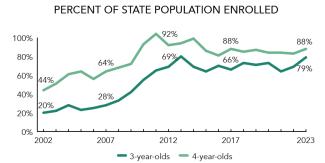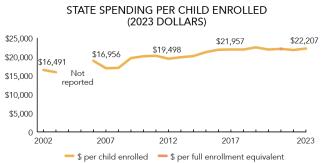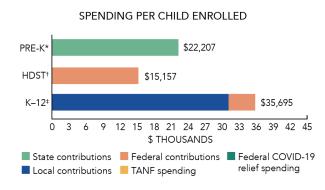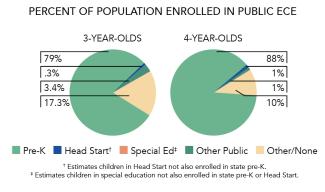
State of Preschool
District of Columbia
Access Rankings
Resource Rankings
Total Benchmarks Met
Overview

During the 2022-2023 school year, the District of Columbia preschool enrolled 12,789 children, an increase of 463 from the prior year. Spending totaled $284,007,157, up $15,143,727 (6%), adjusted for inflation, since last year. Spending per child equaled $22,207 in 2022-2023, up $394 from 2021-2022, adjusted for inflation. The District of Columbia met 4 of 10 quality standards benchmarks.
Background

Among the first in the nation to invest in early education, the District has offered pre-K since the 1960s. The District began to bolster its investment in pre-K significantly through the Pre-K Enhancement and Expansion Amendment Act of 2008 (Pre-K Act). The Pre-K Act provides public, quality, universally accessible pre-K via a mixed-delivery system in the District of Columbia Public Schools (DCPS), Public Charter Schools (PCS), and publicly-funded Community Based Organizations (CBOs) that participate in the Pre-K Enhancement and Expansion Program. The Office of the State Superintendent of Education (OSSE) oversees the District’s Universal Pre-K Program, including programs in DCPS and CBOs. PCSs are authorized and monitored by the DC Public Charter School Board (PCSB). Additionally, the District’s Head Start and Early Head Start grantees serve thousands of children and their families through early learning and comprehensive services and supports; all District Head Start grantees also participate in the universal pre-K system, but may also serve children not eligible for public pre-K.
Pre-K programs operate five days a week for a minimum of 6.5 hours per day and a minimum of 180 instructional days per year. Given the high availability and participation, this program can be considered universal, as the District has a higher percentage of 3- and 4-year-olds enrolled than any U.S. state or territory. Funding for public pre-K programs is based on the Uniform Per Student Funding Formula, with spending per pupil adjusted through a series of weights for higher-cost grade levels and supplemental funding weights for students with additional needs.
Program quality is measured using the CLASS Pre-K, which informs a school rating that is included on each school’s DC School Report Card. The PCSB also uses CLASS Pre-K in its Performance Management Framework, which provides all public charter schools with an annual score. For CBOs, CLASS Pre-K assessments are used for Capital Quality, the District’s QRIS. In the 2022-2023 school year CLASS observations were conducted in 859 pre-K classrooms. CLASS scores, across all observed domains, increased since the 2021-2022 school year continuing a trend of improvement over time since the 2017-2018 school year. Performance across sectors was strong with variation in performance among classrooms within each sector (DCPS, PCS and CBOs) greater than variations between sectors.
District of Columbia Universal Pre-K
Access
Resources
| Total state pre-K spending | $284,007,157 |
| Local match required? | No |
| State Head Start spending | $0 |
| State spending per child enrolled | $22,207 |
| All reported spending per child enrolled* | $22,207 |

*Pre-K programs may receive additional funds from federal or local sources that are not included in this figure. †Head Start per-child spending includes funding only for 3- and 4-year-olds. ‡K–12 expenditures include capital spending as well as current operating expenditures.
District of Columbia Quality Standards Checklist
| Policy | Requirement | Benchmark | Meets Benchmark? |
|---|---|---|---|
For more information about the benchmarks, see the Executive Summary and the Roadmap to State pages. | 4benchmarks met | ||
| Early Learning & Development Standards Benchmark | Comprehensive, aligned, supported, culturally sensitive | Comprehensive, aligned, supported, culturally sensitive | |
| Curriculum Supports Benchmark | Approval process & supports | Approval process & supports | |
| Teacher Degree Benchmark | BA (DCPS & CBO); Determined locally (PCS) | BA | |
| Teacher Specialized Training Benchmark | ECE, Elem. Ed., (DCPS); ECE or related field (CBO); Determined locally (PCS) | Specializing in pre-K | |
| Assistant Teacher Degree Benchmark | AA or Paraprofessional Certification (DCPS); AA (CBO); Determined locally (PCS) | CDA or equivalent | |
| Staff Professional Development Benchmark | 30 hours/year (DCPS teachers); 21 hours/year (CBO teachers & assistants); PD plans (Head Start teachers & CBO teachers & assistants); Coaching (DCPS) | For teachers & assistants: At least 15 hours/year; individual PD plans; coaching | |
| Maximum Class Size Benchmark | DCPS & CBO only: 16 (3-year-olds); 20 (4-year-olds) | 20 or lower | |
| Staff to Child Ratio Benchmark | DCPS & CBO only: 1:8 (3-year-olds); 1:10 (4-year-olds) | 1:10 or better | |
| Screening & Referral Benchmark | Vision, hearing, health & more | Vision, hearing & health screenings; & referral | |
| Continuous Quality Improvement System Benchmark | Structured classroom observations; Data used for program improvement | Structured classroom observations; data used for program improvement | |
